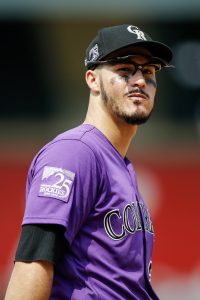Rockies star Nolan Arenado has been a consistent star on both sides of the ball for some time now. He’ll turn 28 early in the 2019 season, meaning that his monster new contract runs through his age-35 season.
It’s easy to like the Rockies’ decision at first glance. Arenado joins Charlie Blackmon as a homegrown star who’ll stick around through his prime. The organization clearly intends to keep a contention window propped open for some time, even if that means committing to some rather lofty spending levels. With other talent on hand, and more intriguing players filtering up through the system, a sustained run of competitiveness is perhaps within reach.
The risks, though, lurk just below the surface. Blackmon took a step back in 2019 and the team has some other hefty commitments to underperforming players. The club will open the 2019 season with over $140MM on the books for the first time and already has north of $110MM obligated for 2020, along with $70MM or so for the following season. Arbitration obligations will rise as well.
Arenado’s deal sets an AAV record for position players and is unquestionably a major commitment. It gives him full no-trade protection, so the Rockies may find it challenging to move the deal if that proves necessary. The team granted Arenado the ability to bail out and test the open market after three seasons, too, meaning he holds the upside with ample downside protection as well. While Arenado would have had a chance to beat seven years and $234MM in free agency next winter, it’s tough to say that represents any kind of discount, particularly when locked in a year in advance.
Paying market value doesn’t mean the Rox were misguided, of course. By doing so now, they kept other clubs from out-bidding or otherwise wooing their best and most popular player. There was obviously a significant risk of being forced to choose between losing Arenado or paying a fair bit more to retain him, particularly with numerous big-market clubs reputedly eyeing him as a target.
All things considered, how do you grade the deal from the Rockies’ perspective? (Link for app users.)
